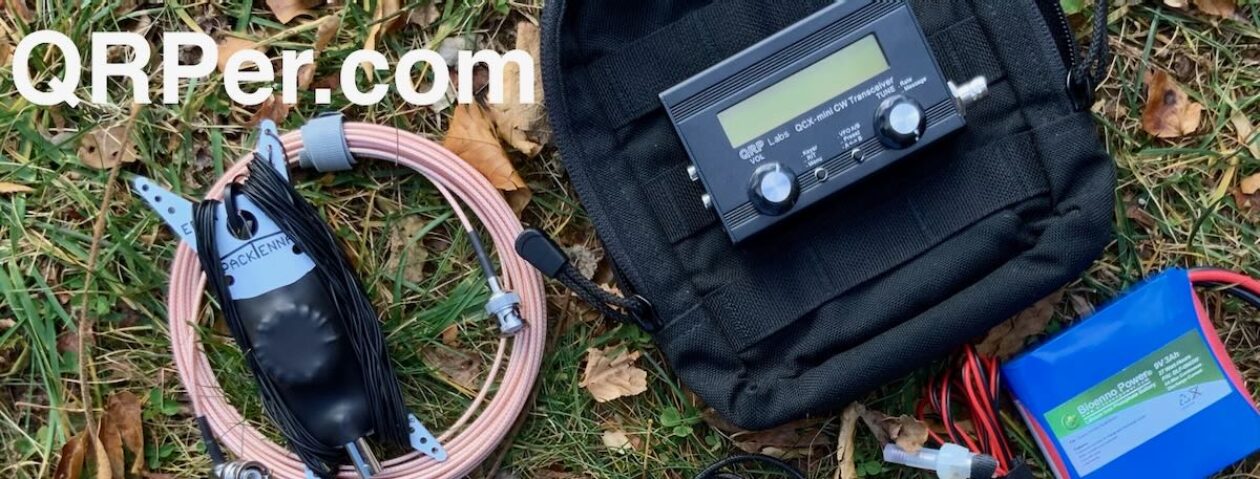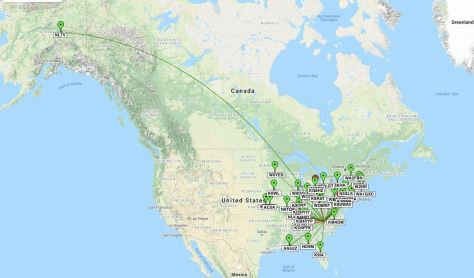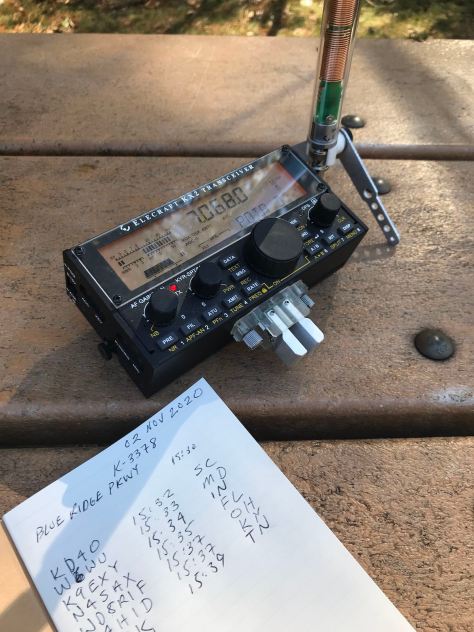 I’ve received no less than three inquiries this weekend from readers who are seeking advice about purchasing a portable external ATU to pair with their Icom IC-705 transceiver.
I’ve received no less than three inquiries this weekend from readers who are seeking advice about purchasing a portable external ATU to pair with their Icom IC-705 transceiver.
Fortunately, there are few options on the market and I believe there is no “right” one because choices are really based on operator preferences.
I’ll do my best to sum up my thoughts below based on the three ATUs I regularly employ and what we know so far about the AH-705 ATU from Icom.
Keep in mind this list will not include some excellent options from LDG, MFJ, and other companies simply because I haven’t used them in the field. Please feel free to add your comments if you have experience with other good options.
Mat-Tuner mAT-705 Plus
 The Mat-Tuner mAT-705 Plus is the first external ATU on the market that directly pairs with the Icom IC-705 via a control cable.
The Mat-Tuner mAT-705 Plus is the first external ATU on the market that directly pairs with the Icom IC-705 via a control cable.
Note that I had issues with the first iteration of the mAT-705 and could not recommend it.
The latest iteration–the mAT-705 Plus–is the ATU I can recommend.
Be careful if purchasing an mAT-705 used as you’ll want to make sure you’re getting the Plus version. The Plus version has a USB-C charging port on the front panel (seen in the photo above)–the original mAT-705 does not (it uses replaceable 9V cells).
Pros:
- Perfectly pairs with the IC-705 for full CAT control
- Wide tuning range
- Tuning is fast and relatively quiet
- Numerous memories making repeat matching rapid
- Internal rechargeable battery
- Rugged chassis
Cons:
- Cannot be paired with other radios without modification (not recommended by the manufacturer)
- At $220 US, it’s not the cheapest option
- Because the IC-705 relies on CAT control for operation, if you leave the control cable at home or on a park bench, you will not be able to operate the ATU. (Pro)Fortunately, the CAT cable is a simple 3 conductor 1/8″ stereo patch cable.
- Not weather-proof
Click here to see the AH-705 Plus in action and read a deeper review.
Summary: If you’re looking for an ATU to take full advantage of IC-705 CAT control, the mAT-705 Plus is a great option. The only significant disadvantage of this ATU is the fact that it only pairs with the IC-705 (or possibly other Icom transceivers with similar CAT control). In other words, you can’t pair it with other QRP transceivers you might own.
Click here to check out the mAT-705 Plus at Vibroplex, DX Engineering, Wimo, and Mat-Tuner.
Elecraft T1
 The Elecraft T1 has been on the market for at least 16 years and is one of the most popular portable antenna tuners on the market.
The Elecraft T1 has been on the market for at least 16 years and is one of the most popular portable antenna tuners on the market.
Elecraft offers the T1 in kit form ($159.95) and factory assembled/tested ($189.95).
The Elecraft T1 has a CAT control port that has been used with the FT-817 in the past. Elecraft recently announced that they will also produce an IC-705 CAT cable that will allow full pairing with the IC-705 transceiver (much like the mAT-705 Plus above).
To be clear, though, the T1 doesn’t need a control cable to function: simply press the TUNEe button for one second, then key your transceiver.
Pros:
- Very wide tuning range
- Soon it will have an IC-705 CAT connection cable option
- Uses common 9V battery that is easy to replace in the field. (Con) Not internally-rechargeable like the mAT-705 Plus.
- One of the most compact automatic ATUs on the market
- Pairs with any 0.5-W to 20-W transceiver covering the 160-6 meter bands
- FT-817 Remote-Control Option
Cons:
- Front panel buttons need protection while in your pack to prevent accidental pressing that will deplete the battery. I 3D-printed this simple cover that works brilliantly.
- Not weather-proof
Summary: The Elecraft T1 is my personal favorite. Since the T1 pairs with any QRP transceiver, I love the flexibility. The T1 has also been on the market for ages and is a solid, safe choice–we know longevity is benchmark. I’ve never been in a situation where the T1 couldn’t find a reasonable match.
I will certainly test the new IC-705 control cable option when it is released in the near future–stay tuned.
Click here to check out the T1 at Elecraft.
Icom AH-705

Disclosure: I have not tested the AH-705 yet, but Icom plans to send me one on loan for review once available in North America.
We do know a bit about the AH-705 because Icom has published details/specifications and some users in Japan have already received units from the first production run.
The AH-705 is Icom’s custom ATU designed to perfectly pair with the Icom IC-705 via control cable. If you want an all-Icom setup, this is it.
Pricing in US dollars is TBD at time of posting, but the announced retail price is $350 .
Pros:
- Perfectly pairs with the IC-705
- Wide tuning range
- 2-way power sources using alkaline batteries (2 x AA cells) or external 13.8 V DC
- IP54 dust-protection and water resistance construction
- Could (potentially–?) be permanently mounted outdoors at the antenna feed point as a dedicated remote tuner
Cons:
- In terms of overall size, the AH-705 appears to be the largest of the portable ATUs mentioned here
- It doesn’t appear AA batteries can be recharged internally
- The AH-705 may (we don’t know yet) only work with the IC-705 and possibly similar Icom models
- The maximum power handling of the AH-705 is 10 watts–if you use other transceivers (if that is even possible) you would have to be extremely careful with power settings.
- The AH-705 is pricey if the actual retail price ends up being near the projected $350 mark. Hopefully, it’ll be much less than this.
- Like the mAT-705 Plus, the AH-705 will require a control cable for operation. (Pro) Of course this means it pairs perfectly with the IC-705 and can follow frequency changes without RF sensing.
Summary: Keep in mind, I have not tested the AH-705 yet, so this is only based on announced specifications.
The strongest selling point for the AH-705? Since the AH-705 is designed to be dust and weather resistant, it could be mounted at the antenna feed point. At home, perhaps it could act like an externally-mounted, remotely-controlled antenna tuner. I’m not sure what the maximum length of the control cable could be, but Icom Japan even lists a 16 foot control cable as an accessory. Of course, you would still need to follow Icom’s guidance about protecting the antenna, transmitter and control cable connection points.
The biggest negative to me is the size. Just check out how large it is compared to the IC-705 in this video. It’s still very portable, but the other ATU options above are much smaller.
Still: if the AH-705 is great at matching antennas and the price ends up falling below the $300 point, I’m sure it’ll be a very popular ATU.
For more information about the AH-705, check out the product page on Icom Japan’s website. I will test a loaner AH-705 in the field this year.
Emtech ZM-2
Another option often overlooked are portable manual antenna tuners. I’m a big fan of the Emtech ZM-2 which is offered both in kit ($62.50) and factory assembled/tested form ($87.50).
It is a manual tuner, so requires manual input to find a match. While it’s not as easy as push-button tuning, it isn’t complicated either.
Here’s my routine:
- I set the top right switch to “GROUND” if using coax feed line and “LINK” if using a balanced line.
- Set the added capacitance switch “ADD” to “0”
- Set the TUNE/OPERATE switch to OPERATE
- I set both capacitors to middle positions (6 on the scale)
- Tune to AM or SSB and listen to the noise floor as I tune the variable capacitors to maximize the noise level. I typically start with the left capacitor, maximize it, then maximize the right capacitor
- If the antenna is particularly challenging, I might add 250 or 500PF via the ADD switch
- Set the TUNE/OPERATE switch to TUNE
- In CW mode, I key down and make fine tuning adjustments with the variable capacitors to make the red tuning LED turn off (high SWR makes the red LED illuminate)
- Set the TUNE/OPERATE switch to OPERATE and hop on the air! (Often, I’ll double-check the SWR on my transceiver).
This sounds complicated, but once you’ve done it even two or three times, it becomes routine. I’ve yet to find a wire antenna the ZM-2 can’t match–it’s a very capable tuner.
Pros:
- The most affordable option listed here
- Very wide matching range
- Portable and very lightweight
- Requires no batteries for operation
- Mechanically simple
- Reliable
Cons:
- Although not complicated, there is a small learning curve involved
- Each time you change bands, you will need to manually re-tune the ZM-2
- Not as fast and hassle-free as an automatic ATU
- Not weather-proof
Summary: I carry the ZM-2 with me even if I plan to use an automatic portable antenna tuner. If my auto ATU loses power for some reason, the ZM-2 will always rescue me. Plus, it’s just as capable of making tough matches as the ATUs above.
I also love using the ZM-2 to match antennas for shortwave broadcast listening outside the ham bands.
Even if you buy an automatic ATU, I would still encourage you to buy a ZM-2 as a backup. It’s affordable, reliable, and very handy.
Click here to check out the Emtech ZM-2.
What are your favorite portable ATUs?
As I mentioned above, these choices are just a small selection of what’s actually available on the market. Please share your favorite portable ATUs and experience by leaving a comment!

















































































